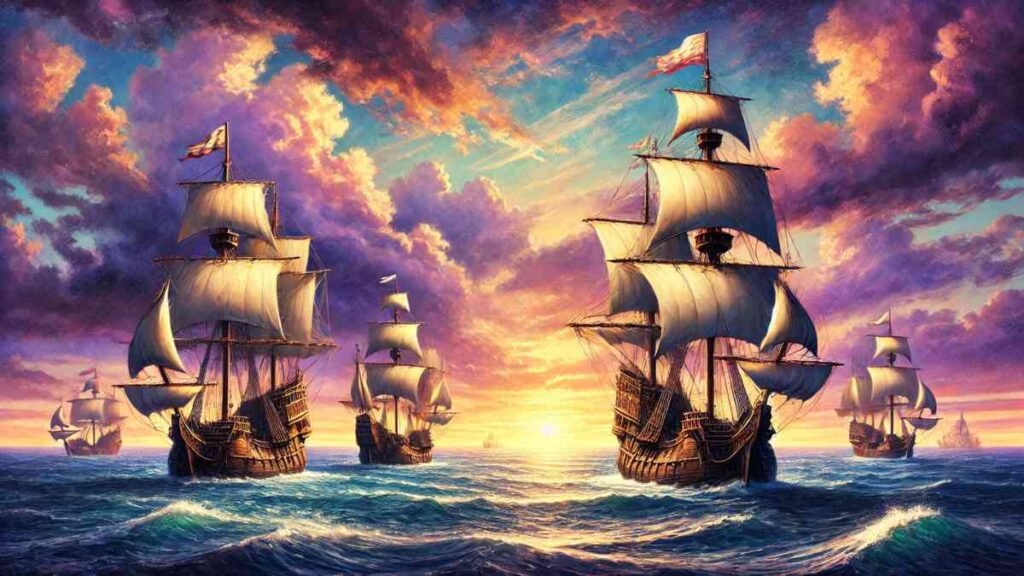In 1492, Christopher Columbus embarked on a historic voyage that marked the beginning of a new era in global exploration. Leaving Spain with hopes of finding a westward route to Asia, Columbus instead encountered the Americas, forever altering the course of history. His journey was a pivotal moment, symbolized by the mnemonic, “In 1492, Columbus sailed the ocean blue,” which encapsulates the importance of this groundbreaking expedition.
Introduction
The year 1492 is etched into history as a turning point in human exploration and discovery. Christopher Columbus’s daring voyage across the Atlantic Ocean not only marked the beginning of European exploration of the Americas but also laid the foundation for transformative global change. This monumental journey opened up new trade routes, fostered cultural exchanges, and reshaped the geopolitical landscape of the time. It was a bold attempt to find a westward route to Asia that instead led to the discovery of a new world. This article explores the historical significance of this event, answering the question: “When did Columbus sail the ocean blue?”
The Motivation Behind the Voyage
The late 15th century was a time of fierce competition among European powers to dominate trade routes to Asia. Spices, silk, and other valuable commodities were highly sought after, and sea routes promised a faster, more reliable alternative to overland travel. Columbus proposed sailing west to reach Asia, an idea that was both revolutionary and risky.
Supported by Spain’s monarchs, Queen Isabella and King Ferdinand, Columbus secured funding for his ambitious plan. His journey was not only about trade but also about spreading Christianity and expanding Spain’s influence.
Preparations for the Journey
Before setting sail, Columbus spent years lobbying European monarchs for support, facing numerous rejections before finally securing approval from Spain. Backed by Queen Isabella and King Ferdinand, he assembled a small fleet with great care. His ships—the Nina, the Pinta, and the Santa Maria—were meticulously prepared with provisions, navigational tools, and essentials for a long and unpredictable journey. Skilled sailors, many from Spanish port towns, joined the expedition, lured by promises of wealth, adventure, and a chance to make history.
The Fleet: The Nina, the Pinta, and the Santa Maria
The three ships that carried Columbus and his crew were modest by modern standards but were well-suited for their time.
- The Santa Maria: The largest of the three, this ship served as Columbus’s flagship.
- The Pinta: Known for its speed, the Pinta was instrumental in scouting ahead.
- The Nina: A smaller but sturdy vessel, the Nina completed all four of Columbus’s voyages.
These ships embarked on their historic journey from Palos de la Frontera on August 3, 1492.
Key Dates of Columbus’s Voyage
- August 3, 1492: Columbus departs from Spain.
- September 6, 1492: After a stop in the Canary Islands, the fleet begins its transatlantic journey.
- October 12, 1492: Land is sighted in the Bahamas, marking the first encounter with the New World.
These milestones are central to answering the question, When did Columbus sail the ocean blue.
The Discovery of the New World
On October 12, 1492, Columbus’s crew sighted land in what is now the Bahamas. This moment marked the European discovery of the Americas. Although Columbus believed he had reached islands near Asia, his journey revealed an entirely new continent to Europeans.
The first encounters between Columbus’s crew and the indigenous Taino people were initially peaceful, but they set the stage for dramatic cultural and economic shifts.
The Impact of 1492 on Global History
Columbus’s journey had profound consequences:
- Cultural Exchange: The Columbian Exchange introduced crops, animals, and diseases between the Old World and the New World.
- Economic Transformation: Spain’s wealth grew as a result of new resources discovered in the Americas.
- Colonial Expansion: Columbus’s voyages paved the way for European colonization, altering the lives of millions.
These changes underscore why the mnemonic When did Columbus sail the ocean blue remains relevant today.
Legacy and Controversy
Columbus’s voyages are celebrated for their historical significance, but they are also the subject of controversy. Critics highlight the devastating impact of European colonization on indigenous populations, including exploitation and the spread of diseases.
Modern historians seek to balance the narrative, acknowledging both Columbus’s achievements and the consequences of his expeditions.
Conclusion
The question “When did Columbus sail the ocean blue?” points to a voyage that reshaped global history and marked the dawn of a new era. In 1492, Columbus’s journey bridged two worlds, setting the stage for centuries of exploration, cultural exchange, and profound transformation. This pivotal expedition not only expanded European horizons but also ushered in significant economic and cultural shifts that defined the modern world. While his legacy remains complex, its historical importance continues to spark discussions and debates worldwide.
For More Visit, MirrorMagazine.co.uk


